 |
| Lady In a Tub at Sunset Valley of the Gods. Bears Ears National Monument. Utah. May 12, 2016. Copyright © 2017 A. F. Litt, All Rights Reserved http://rubble.blogspot.com/2017/06/bears-ears-nm-valley-of-the-gods.html www.aflitt.com/bearsearsnm |
UPDATE: June 16, 2017
Interior Secretary Ryan Zinke has extended the comment public comment period for Bears Ears to July 10, 2017, the same as the rest of the monuments currently under review.
To comment on the monument review process (due July 10, 2017):
-------------------------------------------------------------------------------------------
To comment on the monument review process (due July 10, 2017):
June 12, 2016
Today is Interior Secretary Ryan Zinke's deadline for submitting his review of Bears Ear's monument status... While today might not mark the official end of the monument, no matter what the Secretary recommends, good or bad, it may mark the beginning of the end...
San Juan Record: Sec. Zinke to make Bears Ears recommendation (June 6, 2017)
Saturday, June 10 is the deadline for Secretary of the Interior Ryan Zinke to issue a recommendation on Bears Ears National Monument.
As the deadline nears, Secretary Zinke had one last meeting with San Juan County Commissioners on Monday, June 5 in Washington, DC.
http://sjrnews.com/view/full_story/27428843/article-Sec--Zinke-to-make-Bears-Ears-recommendation
One of the arguments against this monument is that it is "too big." Yes, it is huge. And sites like Butler Wash and Mule Canyon are already well managed and protected by the BLM.
However, there are of thousands of sites like this within the monument, and many of them are pristine... Check out some of the videos through the link at the bottom of this post to see what I mean; they are still filled with pot shards, corncobs, etc.
It's these other sorts of sites that I worry about. It's places like the ancient road at Comb Ridge (which I'll write about later), and other mysteries left by the Ancestral Puebloans that remain to be discovered and understood.
Comb Ridge at SR 95
Bears Ears National Monument. Utah. May 12, 2016.
Copyright © 2017 A. F. Litt, All Rights Reserved
|
Yes, it is large monument, but there are a ton of places worthy of protection within it; spectacular landscapes and countless archaeological sites from a culture we still barely understand.
I recognize a lot of the local concerns, but the agencies that were running these lands before the proclamation will still be running these lands in the future, and a lot of the folks I've seen interviewed seem to think the BLM and Forest Service are doing a fine job. Unfortunately, I wonder how much of their opposition stems from long held anti-Washington and anti-Obama sentiment as much as it does anything else.
Click on Map to Enlarge
|
Ranching will continue, as I know it does in Grand Staircase-Escalante... Maybe with a bit more regulation, but let's face it, ranching on public lands is a real issue that needs to be addressed in the west, and the issues with grazing are deeper and more complex than whether the land has monument status or not.
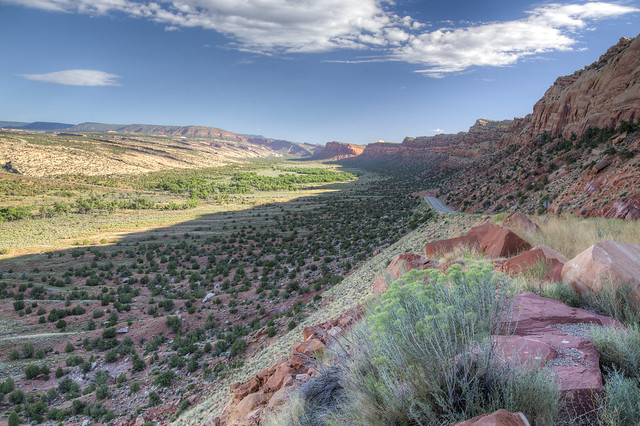
There are fears that the lands will get overrun with too many tourists, but this place isn't going to turn into a circus like Arches, at least not for a very long time. It's one of the reasons I've fallen in love with these monuments and parks that are not run by the National Park Service. I wrote a lot about that last fall in my first post on Grand Staircase-Escalante.
Arches National Park From Anticline Overlook
Bears Ears National Monument / Canyon Rims Recreation Area. Utah. April 25, 2016.
Copyright © 2017 A. F. Litt, All Rights Reserved
|
Also, there are many concerns about access to the lands and potential restrictions on land use. The tribes have been assured that the monument status will, for the most part, not change their traditional use of the lands, though for everyone, there may be some changes in what is allowed where (horses, OTVs, etc.)... But this is why it is so critical that the BLM and Forest Service work together with the locals in coming up with the management plan for the new monument, and that does not change, regardless if these lands remain a monument or not.
Butler Wash Ruins
Bears Ears National Monument. Utah. May 12, 2016.
Copyright © 2017 A. F. Litt, All Rights Reserved
|
So how much will it matter, long run, if it is a monument or not? It will still be the same place, run pretty the well, from what I could see when I was there a year ago, before the proclamation was signed. The BLM and USFS will do a fine job with the land, either way. Really, it comes down to the management plans taking into account the needs of the locals, no matter what happens.
Through these debates, I hope people actually take the time to learn about these lands and that the issues can be discussed on their actual merits; that if there is to be a debate, that it is a real debate, not just partisan wailing and fear-mongering, or just trying to undo what the Democrat presidents did out of nothing but partisan spite.
For my thoughts on the non-National Park Service monuments in general, I wrote a lot about that last fall in my first post on Grand Staircase-Escalante.
 |
| Butler Wash Ruins Bears Ears National Monument. Utah. May 12, 2016. Copyright © 2017 A. F. Litt, All Rights Reserved www.aflitt.com/bearsearsnm |
The Atlantic: Will Bears Ears Remain a National Monument? (June 9, 2017)
Numerous Southwest tribes lived in Bears Ears and consider it sacred, and Utah Diné Bikéyah’s proposal sought to preserve traditional uses of the land while giving tribes a role in managing the area. When legislative efforts to conserve the area failed, leaders from the Navajo, Hopi, Zuni, and Ute tribes joined Diné Bikéyah in lobbying former President Barack Obama to designate Bears Ears a national monument. The monument, announced last December, was a watershed moment in U.S.-tribal relations: Obama’s proclamation took the unprecedented step of designating a commission of tribal leaders to consult on management of the monument.
...
Should the Bears Ears review result in a downsizing, or outright revocation of the monument status, it would be the latest example of the federal government setting aside land in conjunction with tribes, only to break the agreement.“Take the example of the Ute tribes,” said Monte Mills, an assistant professor of American Indian law at the University of Montana. Prior to European-American settlement, the Ute territory stretched across much of Colorado and Utah—Bears Ears included—and as far south as New Mexico. “As non-Indian settlers moved in, the federal government negotiated a treaty in 1868 that recognized their reservation boundaries essentially as the western third of Colorado. Within five years, there was a portion cut out because of the discovery of gold and silver.” A Ute attack on an Indian agency led the government to evict northern Utes from Colorado; their reservation is now in Utah’s oil and gas country. The Southern and Ute Mountain Ute reservations are in Southwest Colorado, south of the mineral-rich San Juan Mountains.
Lawmakers in Utah and some residents of San Juan County, where the monument is located, argue the monument designation is an unjust restriction on resource development, ranching, and motorized access to trails. But Native Americans who petitioned for the monument seek to protect sacred sites, artifacts from ancient dwellings (theft is rampant in the area), and their traditional uses of the land. Gathering herbs, they argue, is impossible on an oil derrick....the Bears Ears monument designation explicitly preserves traditional Native uses of the land. The Utah League of Native American Voters condemned Hatch’s remarks...
On a tour of the region last month, Zinke spent one hour with the Bears Ears Inter-Tribal Coalition. He was there four days; the rest of the visit included meetings with Utah federal, state, and county leaders opposed to the monument.
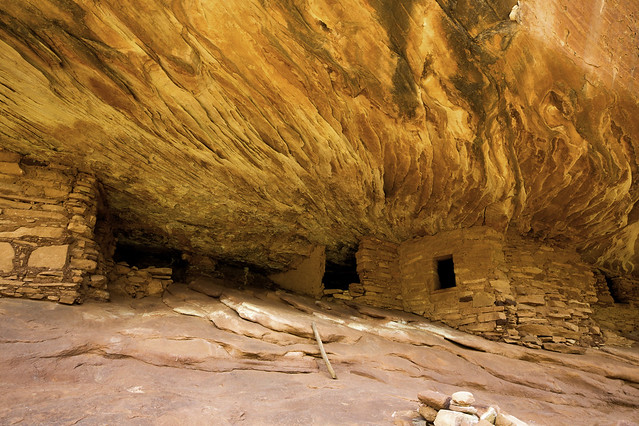
...tribal leaders pledged to challenge any changes to the monument in court. Arguments, Mills said, would likely center on presidential authority to change monuments—the Antiquities Act mentions only monument creation, not alteration. Furthermore, the Obama administration’s engagement with tribes could help preserve Bears Ears by showing the administration exercised due diligence in crafting the smallest appropriate monument, as the Antiquities Act requires. Indeed, the monument as designated is nearly 600,000 acres smaller than the Bears Ears Inter-Tribal Coalition’s proposal.
The review process is another frustrating example of federal questioning of Indian sentiment. “They make you feel like you don’t even know how to use the land,” Yellowman said. “My people got driven off these lands and put on the reservations, and now they are asking us, ‘How are you connected to this land?’ My ancestors lived up there. Our home structures are sitting up there.
“It’s like somebody chases you out of your home and tells you to sleep on the porch.”
 |
| Starting Down the Moki Dugway Bears Ears National Monument. Utah. May 12, 2016. Copyright © 2017 A. F. Litt, All Rights Reserved www.aflitt.com/bearsearsnm |
Theodore Roosevelt IV: Bear Ears: A story of what passes and what endures
The residents of Utah and their representatives, as well as federal land managers, tribal representatives and national environmental groups engaged in a long effort to bridge their differences. Within the scope of an ambitious land management plan for 18 million acres in Utah, called the Public Lands Initiative, they tried to secure greater protection for fragile and important landscapes, such as Bears Ears, while allowing others to be developed for gas and oil resources, providing jobs and tax revenues for surrounding communities.
The process was arduous, marked by both good and bad faith negotiations. Some participants rose to the occasion; others sabotaged it. In the end, the result was failure. The critical problem: in the three years of these negotiations, as new attention put a spotlight on the region, looting of Native American artifacts escalated.
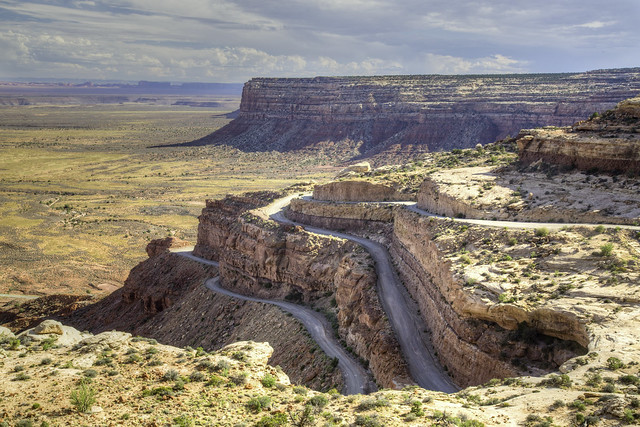
President Obama stepped in and used the Antiquities Act as it was intended: to save lands of archeological, natural or historical significance when Congress fails to do so — when what is at risk is too great to squander.
...
The problems for local communities will not be redressed by rescinding the monument designation, and the dashed hopes of Native Americans will stand as a ruinous memorial, yet again, to our failure to deliver on our promises to them.
We do not save a place by leaving its people desperate and poor. That is not sufficient.
Tourism has been touted as the economic hope for the region. Right now, there are basically no amenities: no hotels, restaurants, signage, visitor centers. Low cost loans and funding need to be secured so that these communities can make necessary business and infrastructure investments and improve their lives accordingly .
Sunset Over Natural Bridges National Monument
Burch Canyon Road, Overlooking Natural Bridges National Monument.
Bears Ears National Monument. Utah. May 13, 2016.
Copyright © 2017 A. F. Litt, All Rights Reserved
|
But a robust rural economy is a diversified one. While the monument designation ended the potential for oil and gas drilling in the protected area that it encompasses; there are other potential areas on public lands elsewhere in the county, which should be explored in good faith for their potential.
The monument designation further promises that grazing and timber/medicinal plant gathering can continue, as well as hunting and fishing. Nonetheless, ranchers and Native Americans in the local communities express concern that those promises will not be kept... those promises must also be stoutly kept, and any group seeking to abrogate them should be censored.
http://www.sltrib.com/opinion/5368689-155/theodore-roosevelt-iv-bear-ears-a
Utah residents to Ryan Zinke: Hands off Bears Ears! (New analysis of submitted comments finds overwhelming in-state support for national monuments)
A full-text search of those comments by the Center for Western Priorities found more than 1,200 self-identified Utahns. Of those Utah residents, 88 percent expressed support for keeping national monuments intact, while 11 percent requested President Trump shrink or rescind monuments.
Some politicians have claimed Utah voices were ignored in the creation of Bears Ears and Grand Staircase–Escalante. The comments, however, reveal a different story: by nearly a nine-to-one margin, Utah residents support their national monuments.
https://medium.com/westwise/utah-residents-to-ryan-zinke-hands-off-bears-ears-e2684046a3b4
 |
Jacobs Chair Above White Canyon
Bears Ears National Monument. Utah. May 14, 2016.
Copyright © 2017 A. F. Litt, All Rights Reserved
|
Op-ed: State politicians may not support our newest monument but real Utahns do (June 9, 2017)
In fact, 64 percent of Utah's likely voters support keeping Bears Ears as a national monument, at its current size. Only 30 percent oppose the monument. Further, by a nearly two-to-one margin, voters believe that the monument designation has been a "good thing" for Utah.
...
Survey respondents affirmed that their beliefs don't square with the actions of the elected officials who represent them. Utahns clearly care about access to public lands, because 9 in 10 had visited national public lands in the past year, and 1 in 10 had done so more than 10 times. We also care about the cultural treasures held within Bears Ears, with 84 percent saying that better protecting Native American and historic artifacts are "very" or "extremely" important reasons to support the monument.
The results beg the question: Why does Utah's congressional delegation persist in trying to strip protections from Bears Ears? The only answer that makes sense is that this is a personal political agenda to turn back the clock on Utah's economy and its relationships with tribes.
http://www.sltrib.com/opinion/5359199-155/op-ed-state-politicians-may-not-support
 |
| Goosenecks Panorama (B/W) Goosenecks State Park / Bears Ears National Monument. Utah. May 13, 2016 Copyright © 2017 A. F. Litt, All Rights Reserved www.aflitt.com/bearsearsnm |
NPR: Interior Secretary Ryan Zinke Reviews Bears Ears National Monument (June 9, 2017)
Bears Ears is really what spurred on this larger executive order asking the interior secretary, Ryan Zinke, to review the monuments. It's the latest example of a large piece of protected federal land that was done by a president executive order and not through Congress. And that's very contentious in particular for many Republicans in Congress. And reversing it would be seen as something that would certainly appeal to Mr. Trump's base.
I would be very surprised, Audie, to see the interior secretary recommend that the 1.3 million-acre monument itself be left completely intact. I think - sources on both sides are telling me they're expecting it to either be abolished or recommended to be abolished or at least shrunk. And I think this decision is going to give us a pretty clear early indication, anyway, on how the administration is going to act on a lot of public lands issues - in particular, species protection and drilling and whatnot - that go way beyond just this monument and the others in the review.
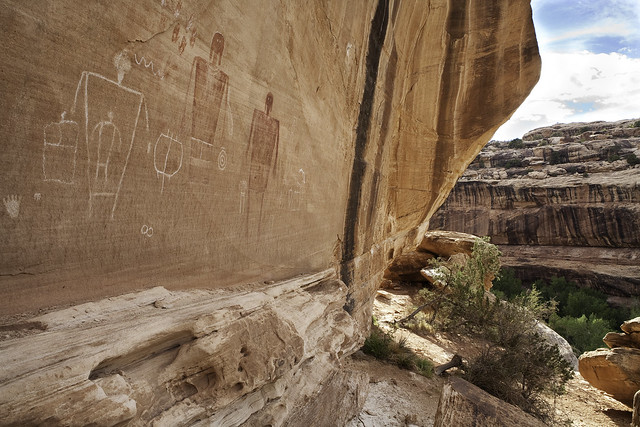
I think it's likely to go to court either way. The law here is gray about whether a president can actually abolish a national monument. Prior precedent says that only Congress can. The interior secretary, Ryan Zinke, has hinted as early as in his confirmation hearings that this law may need to be tested.
And there is already some echoes here of some big protests that may be in the works not unlike the land occupation and the protests we saw up in North Dakota over the pipeline at Standing Rock. As we speak right now, Audie, my inbox is clogged with press releases notifying me that tribes are meeting within the national monument right now in solidarity of protecting the land down in southeastern Utah.
 |
| Kiva at Mule Creek Ruins Bears Ears National Monument. Utah. May 13, 2016. Copyright © 2017 A. F. Litt, All Rights Reserved www.aflitt.com/bearsearsnm |
NPR: What Utah's Canyon Country Can Tell Us About Trump's Monuments Review (June 10, 2017)
This article is mostly focused on Grand Staircase-Escalante National Monument, which is number two on the Trump Administrations hit list, but it deals with many of the same issues as Bears Ears, and it is a good look at the longer term effects of these sorts of monuments, since it was the first one to be managed by the BLM and just turned 20 years old.
This article is mostly focused on Grand Staircase-Escalante National Monument, which is number two on the Trump Administrations hit list, but it deals with many of the same issues as Bears Ears, and it is a good look at the longer term effects of these sorts of monuments, since it was the first one to be managed by the BLM and just turned 20 years old.
Mule Canyon Ruins, Flowers, and Tree
Bears Ears National Monument. Utah. May 12, 2016.
Copyright © 2017 A. F. Litt, All Rights Reserved
|
Preamble to the Presidential Proclamation Establishing Bears Ears National Monument:
Rising from the center of the southeastern Utah landscape and visible from every direction are twin buttes so distinctive that in each of the native languages of the region their name is the same: Hoon'Naqvut, Shash Jáa, Kwiyagatu Nukavachi, Ansh An Lashokdiwe, or "Bears Ears." For hundreds of generations, native peoples lived in the surrounding deep sandstone canyons, desert mesas, and meadow mountaintops, which constitute one of the densest and most significant cultural landscapes in the United States. Abundant rock art, ancient cliff dwellings, ceremonial sites, and countless other artifacts provide an extraordinary archaeological and cultural record that is important to us all, but most notably the land is profoundly sacred to many Native American tribes, including the Ute Mountain Ute Tribe, Navajo Nation, Ute Indian Tribe of the Uintah Ouray, Hopi Nation, and Zuni Tribe.
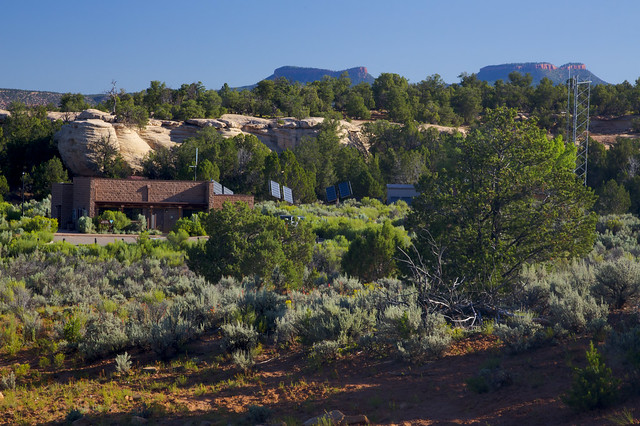
The area's human history is as vibrant and diverse as the ruggedly beautiful landscape. From the earliest occupation, native peoples left traces of their presence. Clovis people hunted among the cliffs and canyons of Cedar Mesa as early as 13,000 years ago, leaving behind tools and projectile points in places like the Lime Ridge Clovis Site, one of the oldest known archaeological sites in Utah. Archaeologists believe that these early people hunted mammoths, ground sloths, and other now-extinct megafauna, a narrative echoed by native creation stories. Hunters and gatherers continued to live in this region in the Archaic Period, with sites dating as far back as 8,500 years ago.
 |
| CLICK ON IMAGE TO ENLARGE https://www.blm.gov/sites/blm.gov/files/UT_BearsEars_NM.pdf |
Ancestral Puebloans followed, beginning to occupy the area at least 2,500 years ago, leaving behind items from their daily life such as baskets, pottery, and weapons. These early farmers of Basketmaker II, and III and builders of Pueblo I, II and III left their marks on the land. The remains of single family dwellings, granaries, kivas, towers, and large villages and roads linking them together reveal a complex cultural history. "Moki steps," hand and toe holds carved into steep canyon walls by the Ancestral Puebloans, illustrate the early people's ingenuity and perseverance and are still used today to access dwellings along cliff walls. Other, distinct cultures have thrived here as well -- the Fremont People, Numic- and Athabaskan-speaking hunter-gatherers, and Utes and Navajos. Resources such as the Doll House Ruin in Dark Canyon Wilderness Area and the Moon House Ruin on Cedar Mesa allow visitors to marvel at artistry and architecture that have withstood thousands of seasons in this harsh climate.
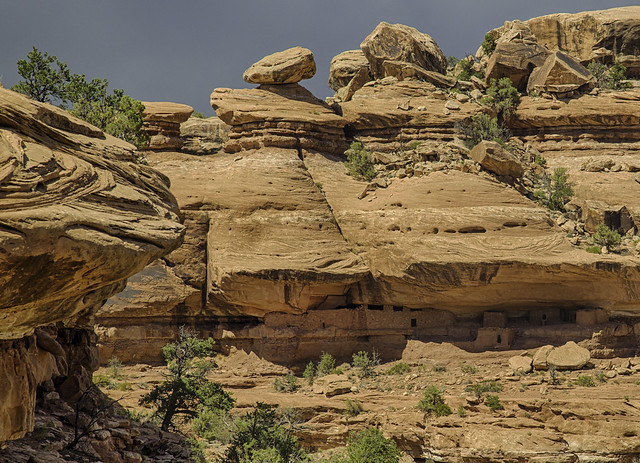
The landscape is a milieu of the accessible and observable together with the inaccessible and hidden. The area's petroglyphs and pictographs capture the imagination with images dating back at least 5,000 years and spanning a range of styles and traditions. From life-size ghostlike figures that defy categorization, to the more literal depictions of bighorn sheep, birds, and lizards, these drawings enable us to feel the humanity of these ancient artists. The Indian Creek area contains spectacular rock art, including hundreds of petroglyphs at Newspaper Rock. Visitors to Bears Ears can also discover more recent rock art left by the Ute, Navajo, and Paiute peoples. It is also the less visible sites, however -- those that supported the food gathering, subsistence and ceremony of daily life -- that tell the story of the people who lived here. Historic remnants of Native American sheep-herding and farming are scattered throughout the area, and pottery and Navajo hogans record the lifeways of native peoples in the 19th and 20th centuries.
Newspaper Rock
Bears Ears National Monument / Newspaper Rock State Historic Monument. Utah. May 7, 2016.
Copyright © 2017 A. F. Litt, All Rights Reserved
|
 |
| Instagram: Cliffs Above Indian Creek Bears Ears National Monument / Indian Creek Recreation Area. Utah. May 7, 2016. Copyright © 2016 A. F. Litt, All Rights Reserved www.aflitt.com/bearsearsnm https://www.instagram.com/p/BFIFdwIHCmc |
For thousands of years, humans have occupied and stewarded this land. With respect to most of these people, their contribution to the historical record is unknown, but some have played a more public role. Famed Navajo headman K'aayélii was born around 1800 near the twin Bears Ears buttes. His band used the area's remote canyons to elude capture by the U.S. Army and avoid the fate that befell many other Navajo bands: surrender, the Long Walk, and forced relocation to Bosque Redondo. Another renowned 19th century Navajo leader, "Hastiin Ch'ihaajin" Manuelito, was also born near the Bears Ears.
The area's cultural importance to Native American tribes continues to this day. As they have for generations, these tribes and their members come here for ceremonies and to visit sacred sites. Throughout the region, many landscape features, such as Comb Ridge, the San Juan River, and Cedar Mesa, are closely tied to native stories of creation, danger, protection, and healing. The towering spires in the Valley of the Gods are sacred to the Navajo, representing ancient Navajo warriors frozen in stone. Traditions of hunting, fishing, gathering, and wood cutting are still practiced by tribal members, as is collection of medicinal and ceremonial plants, edible herbs, and materials for crafting items like baskets and footwear. The traditional ecological knowledge amassed by the Native Americans whose ancestors inhabited this region, passed down from generation to generation, offers critical insight into the historic and scientific significance of the area. Such knowledge is, itself, a resource to be protected and used in understanding and managing this landscape sustainably for generations to come.
 |
| The Wine Glass Bears Ears National Monument / Canyon Rims Recreation Area. Utah. April 25, 2016. Copyright © 2017 A. F. Litt, All Rights Reserved www.aflitt.com/bearsearsnm |
Euro-Americans first explored the Bears Ears area during the 18th century, and Mormon settlers followed in the late 19th century. The San Juan Mission expedition traversed this rugged country in 1880 on their journey to establish a new settlement in what is now Bluff, Utah. To ease the passage of wagons over the slick rock slopes and through the canyonlands, the settlers smoothed sections of the rock surface and constructed dugways and other features still visible along their route, known as the Hole-in-the-Rock Trail. Cabins, corrals, trails, and carved inscriptions in the rock reveal the lives of ranchers, prospectors, and early archaeologists. Cattle rustlers and other outlaws created a convoluted trail network known as the Outlaw Trail, said to be used by Butch Cassidy and the Sundance Kid. These outlaws took advantage of the area's network of canyons, including the aptly-named Hideout Canyon, to avoid detection.
The area's stunning geology, from sharp pinnacles to broad mesas, labyrinthine canyons to solitary hoodoos, and verdant hanging gardens to bare stone arches and natural bridges, provides vital insights to geologists. In the east, the Abajo Mountains tower, reaching elevations of more than 11,000 feet. A long geologic history is documented in the colorful rock layers visible in the area's canyons.
 |
| The Road to Minor Overlook Bears Ears National Monument / Canyon Rims Recreation Area. Utah. April 25, 2016. Copyright © 2017 A. F. Litt, All Rights Reserved www.aflitt.com/bearsearsnm |
For long periods over 300 million years ago, these lands were inundated by tropical seas and hosted thriving coral reefs. These seas infused the area's black rock shale with salts as they receded. Later, the lands were bucked upwards multiple times by the Monument Upwarp, and near-volcanoes punched up through the rock, leaving their marks on the landscape without reaching the surface. In the sandstone of Cedar Mesa, fossil evidence has revealed large, mammal-like reptiles that burrowed into the sand to survive the blistering heat of the end of the Permian Period, when the region was dominated by a seaside desert. Later, in the Late Triassic Period more than 200 million years ago, seasonal monsoons flooded an ancient river system that fed a vast desert here.
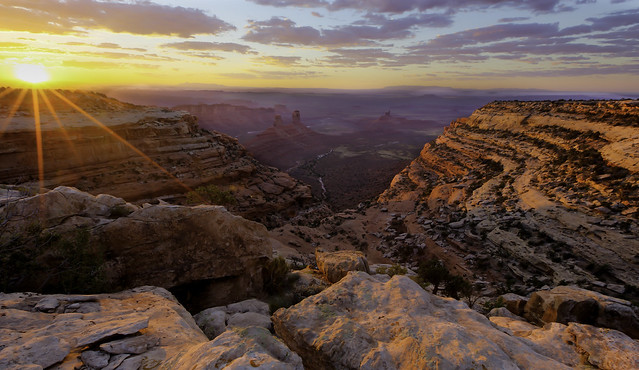
The paleontological resources in the Bears Ears area are among the richest and most significant in the United States, and protection of this area will provide important opportunities for further archaeological and paleontological study. Many sites, such as Arch Canyon, are teeming with fossils, and research conducted in the Bears Ears area is revealing new insights into the transition of vertebrate life from reptiles to mammals and from sea to land. Numerous ray-finned fish fossils from the Permian Period have been discovered, along with other late Paleozoic Era fossils, including giant amphibians, synapsid reptiles, and important plant fossils. Fossilized traces of marine and aquatic creatures such as clams, crayfish, fish, and aquatic reptiles have been found in Indian Creek's Chinle Formation, dating to the Triassic Period, and phytosaur and dinosaur fossils from the same period have been found along Comb Ridge. Paleontologists have identified new species of plant-eating crocodile-like reptiles and mass graves of lumbering sauropods, along with metoposaurus, crocodiles, and other dinosaur fossils. Fossilized trackways of early tetrapods can be seen in the Valley of the Gods and in Indian Creek, where paleontologists have also discovered exceptional examples of fossilized ferns, horsetails, and cycads. The Chinle Formation and the Wingate, Kayenta, and Navajo Formations above it provide one of the best continuous rock records of the Triassic-Jurassic transition in the world, crucial to understanding how dinosaurs dominated terrestrial ecosystems and how our mammalian ancestors evolved. In Pleistocene Epoch sediments, scientists have found traces of mammoths, short-faced bears, ground sloths, primates, and camels.
From earth to sky, the region is unsurpassed in wonders. The star-filled nights and natural quiet of the Bears Ears area transport visitors to an earlier eon. Against an absolutely black night sky, our galaxy and others more distant leap into view. As one of the most intact and least roaded areas in the contiguous United States, Bears Ears has that rare and arresting quality of deafening silence.
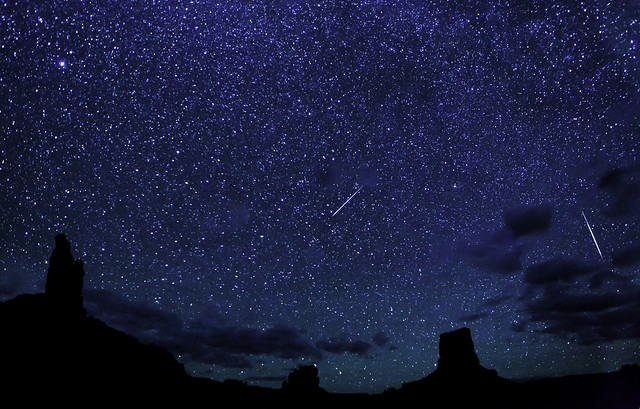
Communities have depended on the resources of the region for hundreds of generations. Understanding the important role of the green highlands in providing habitat for subsistence plants and animals, as well as capturing and filtering water from passing storms, the Navajo refer to such places as "Nahodishgish," or places to be left alone. Local communities seeking to protect the mountains for their watershed values have long recognized the importance of the Bears Ears' headwaters. Wildfires, both natural and human-set, have shaped and maintained forests and grasslands of this area for millennia. Ranchers have relied on the forests and grasslands of the region for ages, and hunters come from across the globe for a chance at a bull elk or other big game. Today, ecological restoration through the careful use of wildfire and management of grazing and timber is working to restore and maintain the health of these vital watersheds and grasslands.
The diversity of the soils and microenvironments in the Bears Ears area provide habitat for a wide variety of vegetation. The highest elevations, in the Elk Ridge area of the Manti-La Sal National Forest, contain pockets of ancient Engelmann spruce, ponderosa pine, aspen, and subalpine fir. Mesa tops include pinyon-juniper woodlands along with big sagebrush, low sage, blackbrush, rabbitbrush, bitterbrush, four-wing saltbush, shadscale, winterfat, Utah serviceberry, western chokecherry, hackberry, barberry, cliff rose, and greasewood. Canyons contain diverse vegetation ranging from yucca and cacti such as prickly pear, claret cup, and Whipple's fishhook to mountain mahogany, ponderosa pine, alder, sagebrush, birch, dogwood, and Gambel's oak, along with occasional stands of aspen. Grasses and herbaceous species such as bluegrass, bluestem, giant ryegrass, ricegrass, needle and thread, yarrow, common mallow, balsamroot, low larkspur, horsetail, and peppergrass also grow here, as well as pinnate spring parsley, Navajo penstemon, Canyonlands lomatium, and the Abajo daisy.
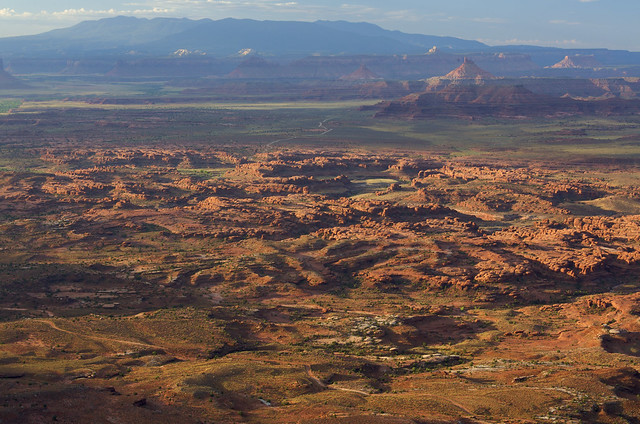
Tucked into winding canyons are vibrant riparian communities characterized by Fremont cottonwood, western sandbar willow, yellow willow, and box elder. Numerous seeps provide year-round water and support delicate hanging gardens, moisture-loving plants, and relict species such as Douglas fir. A few populations of the rare Kachina daisy, endemic to the Colorado Plateau, hide in shaded seeps and alcoves of the area's canyons. A genetically distinct population of Kachina daisy was also found on Elk Ridge. The alcove columbine and cave primrose, also regionally endemic, grow in seeps and hanging gardens in the Bears Ears landscape. Wildflowers such as beardtongue, evening primrose, aster, Indian paintbrush, yellow and purple beeflower, straight bladderpod, Durango tumble mustard, scarlet gilia, globe mallow, sand verbena, sego lily, cliffrose, sacred datura, monkey flower, sunflower, prince's plume, hedgehog cactus, and columbine, bring bursts of color to the landscape.
The diverse vegetation and topography of the Bears Ears area, in turn, support a variety of wildlife species. Mule deer and elk range on the mesas and near canyon heads, which provide crucial habitat for both species. The Cedar Mesa landscape is home to bighorn sheep which were once abundant but still live in Indian Creek, and in the canyons north of the San Juan River. Small mammals such as desert cottontail, black-tailed jackrabbit, prairie dog, Botta's pocket gopher, white-tailed antelope squirrel, Colorado chipmunk, canyon mouse, deer mouse, pinyon mouse, and desert woodrat, as well as Utah's only population of Abert's tassel-eared squirrels, find shelter and sustenance in the landscape's canyons and uplands. Rare shrews, including a variant of Merriam's shrew and the dwarf shrew can be found in this area.
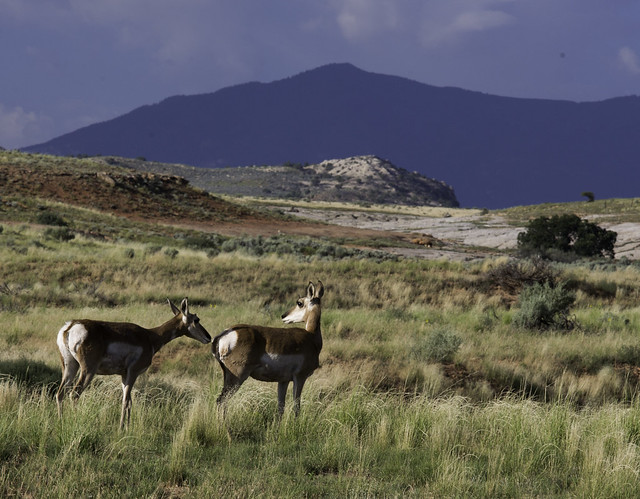
Carnivores, including badger, coyote, striped skunk, ringtail, gray fox, bobcat, and the occasional mountain lion, all hunt here, while porcupines use their sharp quills and climbing abilities to escape these predators. Oral histories from the Ute describe the historic presence of bison, antelope, and abundant bighorn sheep, which are also depicted in ancient rock art. Black bear pass through the area but are rarely seen, though they are common in the oral histories and legends of this region, including those of the Navajo.
Consistent sources of water in a dry landscape draw diverse wildlife species to the area's riparian habitats, including an array of amphibian species such as tiger salamander, red-spotted toad, Woodhouse's toad, canyon tree frog, Great Basin spadefoot, and northern leopard frog. Even the most sharp-eyed visitors probably will not catch a glimpse of the secretive Utah night lizard. Other reptiles in the area include the sagebrush lizard, eastern fence lizard, tree lizard, side-blotched lizard, plateau striped whiptail, western rattlesnake, night snake, striped whipsnake, and gopher snake.
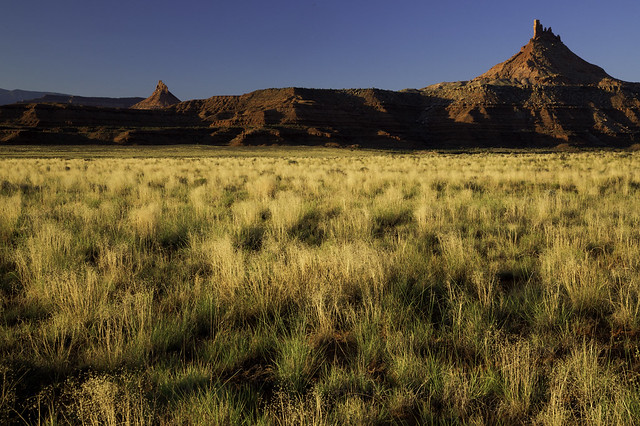
Raptors such as the golden eagle, peregrine falcon, bald eagle, northern harrier, northern goshawk, red-tailed hawk, ferruginous hawk, American kestrel, flammulated owl, and great horned owl hunt their prey on the mesa tops with deadly speed and accuracy. The largest contiguous critical habitat for the threatened Mexican spotted owl is on the Manti-La Sal National Forest. Other bird species found in the area include Merriam's turkey, Williamson's sapsucker, common nighthawk, white-throated swift, ash-throated flycatcher, violet-green swallow, cliff swallow, mourning dove, pinyon jay, sagebrush sparrow, canyon towhee, rock wren, sage thrasher, and the endangered southwestern willow flycatcher.
 |
Sunset near the Valley of the Gods
Bears Ears National Monument. Utah. May 12, 2016.
Copyright © 2017 A. F. Litt, All Rights Reserved
|
As the skies darken in the evenings, visitors may catch a glimpse of some the area's at least 15 species of bats, including the big free-tailed bat, pallid bat, Townsend's big-eared bat, spotted bat, and silver-haired bat. Tinajas, rock depressions filled with rainwater, provide habitat for many specialized aquatic species, including pothole beetles and freshwater shrimp. Eucosma navajoensis, an endemic moth that has only been described near Valley of the Gods, is unique to this area.
 |
| Morning in the Valley of the Gods Bears Ears National Monument. Utah. May 13, 2016. Copyright © 2017 A. F. Litt, All Rights Reserved www.aflitt.com/bearsearsnm |
Protection of the Bears Ears area will preserve its cultural, prehistoric, and historic legacy and maintain its diverse array of natural and scientific resources, ensuring that the prehistoric, historic, and scientific values of this area remain for the benefit of all Americans. The Bears Ears area has been proposed for protection by members of Congress, Secretaries of the Interior, State and tribal leaders, and local conservationists for at least 80 years. The area contains numerous objects of historic and of scientific interest, and it provides world class outdoor recreation opportunities, including rock climbing, hunting, hiking, backpacking, canyoneering, whitewater rafting, mountain biking, and horseback riding. Because visitors travel from near and far, these lands support a growing travel and tourism sector that is a source of economic opportunity for the region.
https://obamawhitehouse.archives.gov/the-press-office/2016/12/28/proclamation-establishment-bears-ears-national-monument
 |
| The Bears Ears From Natural Bridges NM Natural Bridges National Monument. Utah. May 12, 2016. Copyright © 2017 A. F. Litt, All Rights Reserved www.aflitt.com/naturalbridgesnm www.aflitt.com/bearsearsnm |
 |
| Interpretive Sign: Bears Ears Natural Bridges National Monument. Utah. May 12, 2016. CLICK ON IMAGE TO ENLARGE |
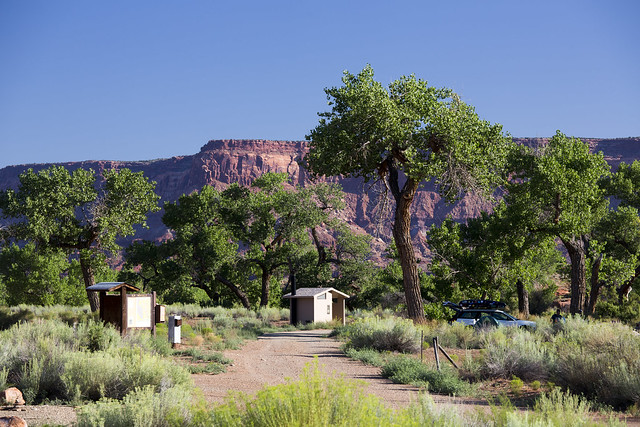
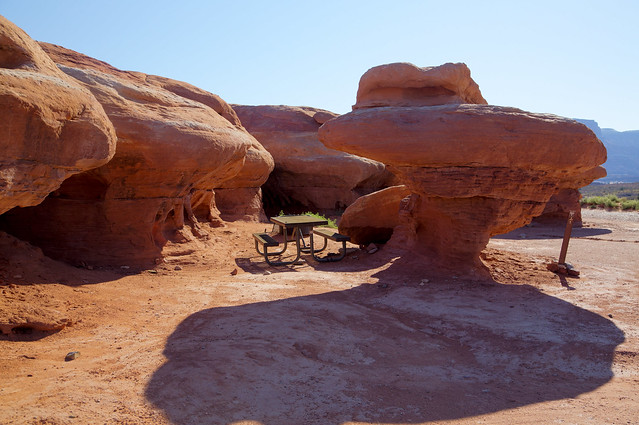
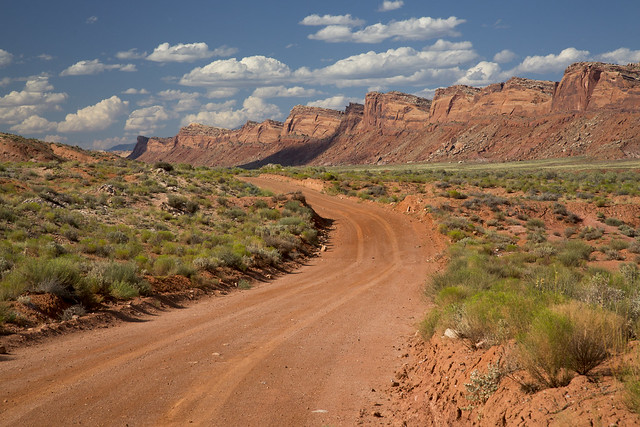
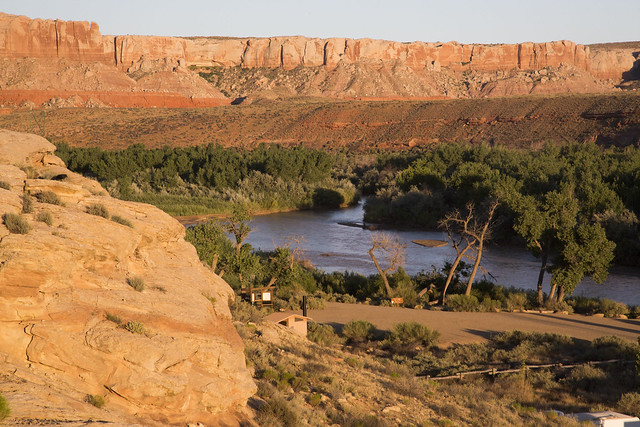
BLM: Bears Ears National Monument Map (as of June 2017) - PDF
Links
National Monuments in Danger:
CLICK HERE for posts about the monuments being "reviewed" by the Trump Administration
To comment on the monument review process (due July 10, 2017):
Rubble:
Bears Ears National Monument: A Quick Tour of a Monument at Risk
http://rubble.blogspot.com/2017/06/bears-ears-nm-quick-tour.html
Bears Ears National Monument: Video and Links Collection
Bears Ears National Monument: Valley of the Gods
Bears Ears National Monument: Jacobs Chair
Bears Ears National Monument: Butler Wash
BLM:
Website:
https://www.blm.gov/programs/national-conservation-lands/utah/bears-ears-national-monument
BLM Utah on flikr:
BLM on flikr:
https://flic.kr/s/aHskNHMMoC
Grand Gulch Map:
https://www.blm.gov/sites/blm.gov/files/documents/files/BLMUtahGrandGulchMap.pdf
Bear Ears National Monument Map (Very detailed - the best one I've found):
Wikipedia:
Bears Ears NM: https://en.m.wikipedia.org/wiki/Bears_Ears_National_Monument
Department of the Interior:
Department of the Interior Press release on Bears Ears Monument Review (June 13, 2017)
https://www.regulations.gov/document?D=DOI-2017-0002-153322
Presidential Proclamation -- Establishment of the Bears Ears National Monument:
Bears Ears Inter-Tribal Coalition:
Friends of Cedar Mesa:
Instagram:
The Atlantic: Will Bears Ears Remain a National Monument?
Utah residents to Ryan Zinke: Hands off Bears Ears! (New analysis of submitted comments finds overwhelming in-state support for national monuments)
https://medium.com/westwise/utah-residents-to-ryan-zinke-hands-off-bears-ears-e2684046a3b4
Salt Lake Tribune:
Sources: Zinke to urge diminishing size of Bears Ears National Monument (June 12, 2017)
Bagley Cartoon: Bears Ears Bits (June 12, 2017)
http://www.sltrib.com/opinion/5394825-155/bagley-cartoon-bears-ears-bits
Published June 10, 2017
Navajo elder says Utah leaders ‘never supported’ preserving sacred American Indian sites (June 9, 2017)
http://www.sltrib.com/news/5385484-155/navajo-elder-says-utah-leaders-never
Op-ed: State politicians may not support our newest monument but real Utahns do (June 9, 2017)
Theodore Roosevelt IV: Bear Ears: A story of what passes and what endures (June 5, 2017)
BLM yanks oil and gas leases proposed near Zion after complaints from residents (June 2, 2017)
Some urge more public input as Bears Ears’ fate looms
Published May 15, 2017
I gave Utah a voice, Zinke says as he departs from national-monument trip
Published May 14, 2017
After hearing from Utahns, Zinke confident he can resolve conflict over Bears Ears National Monument
Published May 11, 2017
Zinke flies over Bears Ears as critics urge him to ‘Make San Juan County Great Again’ and rescind monument
Published May 10, 2017
Jewell defends Bears Ears monument process (April 26, 2017)
Deseret News:
BLM, Forest Service plotting next steps for Bears Ears
San Juan Record:
Secretary Zinke recommends reduced size of Bears Ears National Monument (June 13, 2017)
Sec. Zinke to make Bears Ears recommendation (June 6, 2017)
Bears Ears National Monument designation disastrous for Utah grassroots Navajos (April 12, 2016)
http://sjrnews.com/view/full_story/27152945/article-Bears-Ears-National-Monument-designation-disastrous-for-Utah-grassroots-Navajos
NPR:
Interior Secretary Ryan Zinke Reviews Bears Ears National Monument (June 9, 2017)
http://www.npr.org/2017/06/09/532289014/interior-secretary-ryan-zinke-reviews-bears-ears-national-monument
With National Monuments Under Review, Bears Ears Is Focus Of Fierce Debate (May 5, 2017)
http://www.npr.org/2017/05/05/526860725/with-national-monuments-under-review-bears-ears-is-focus-of-fierce-debate
Utah’s Bears Ears monument is a rock star for night skies – and mineral resources
The Wilderness Society:
Photo gallery: Utah's Bears Ears region is a natural & cultural treasure
Unprecedented outpouring of support for Bears Ears shown during official comment period
To comment on the monument review process (due July 10, 2017):
Rubble:
Bears Ears National Monument: A Quick Tour of a Monument at Risk
http://rubble.blogspot.com/2017/06/bears-ears-nm-quick-tour.html
http://rubble.blogspot.com/2017/06/bears-ears-nm-quick-tour.html
Bears Ears National Monument: Video and Links Collection
Bears Ears National Monument: Valley of the Gods
Bears Ears National Monument: Jacobs Chair
Bears Ears National Monument: Butler Wash
BLM:
Website:
https://www.blm.gov/programs/national-conservation-lands/utah/bears-ears-national-monument
BLM Utah on flikr:
BLM on flikr: BLM Utah on flikr:
https://flic.kr/s/aHskNHMMoC
Grand Gulch Map:
https://www.blm.gov/sites/blm.gov/files/documents/files/BLMUtahGrandGulchMap.pdf
Grand Gulch Map:
https://www.blm.gov/sites/blm.gov/files/documents/files/BLMUtahGrandGulchMap.pdf
Bear Ears National Monument Map (Very detailed - the best one I've found):
Wikipedia:
Bears Ears NM: https://en.m.wikipedia.org/wiki/Bears_Ears_National_Monument
Department of the Interior:
Department of the Interior Press release on Bears Ears Monument Review (June 13, 2017)
https://www.regulations.gov/document?D=DOI-2017-0002-153322
Presidential Proclamation -- Establishment of the Bears Ears National Monument:
Utah residents to Ryan Zinke: Hands off Bears Ears! (New analysis of submitted comments finds overwhelming in-state support for national monuments)Presidential Proclamation -- Establishment of the Bears Ears National Monument:
Bears Ears Inter-Tribal Coalition:
Friends of Cedar Mesa:
Instagram:
The Atlantic: Will Bears Ears Remain a National Monument?
https://medium.com/westwise/utah-residents-to-ryan-zinke-hands-off-bears-ears-e2684046a3b4
Salt Lake Tribune:
Bagley Cartoon: Bears Ears Bits (June 12, 2017)
http://www.sltrib.com/opinion/5394825-155/bagley-cartoon-bears-ears-bits
Navajo elder says Utah leaders ‘never supported’ preserving sacred American Indian sites (June 9, 2017)
http://www.sltrib.com/news/5385484-155/navajo-elder-says-utah-leaders-never
Some urge more public input as Bears Ears’ fate looms
Published May 15, 2017
I gave Utah a voice, Zinke says as he departs from national-monument trip
Published May 14, 2017
After hearing from Utahns, Zinke confident he can resolve conflict over Bears Ears National Monument
Published May 11, 2017
Zinke flies over Bears Ears as critics urge him to ‘Make San Juan County Great Again’ and rescind monument
Published May 10, 2017
Sources: Zinke to urge diminishing size of Bears Ears National Monument (June 12, 2017)
http://www.sltrib.com/opinion/5394825-155/bagley-cartoon-bears-ears-bits
Published June 10, 2017
http://www.sltrib.com/news/5385484-155/navajo-elder-says-utah-leaders-never
Op-ed: State politicians may not support our newest monument but real Utahns do (June 9, 2017)
Theodore Roosevelt IV: Bear Ears: A story of what passes and what endures (June 5, 2017)
BLM yanks oil and gas leases proposed near Zion after complaints from residents (June 2, 2017)
Some urge more public input as Bears Ears’ fate looms
Published May 15, 2017
I gave Utah a voice, Zinke says as he departs from national-monument trip
Published May 14, 2017
After hearing from Utahns, Zinke confident he can resolve conflict over Bears Ears National Monument
Published May 11, 2017
Zinke flies over Bears Ears as critics urge him to ‘Make San Juan County Great Again’ and rescind monument
Published May 10, 2017
Jewell defends Bears Ears monument process (April 26, 2017)
Deseret News:
BLM, Forest Service plotting next steps for Bears Ears
San Juan Record:
Secretary Zinke recommends reduced size of Bears Ears National Monument (June 13, 2017)
Sec. Zinke to make Bears Ears recommendation (June 6, 2017)
Bears Ears National Monument designation disastrous for Utah grassroots Navajos (April 12, 2016)
http://sjrnews.com/view/full_story/27152945/article-Bears-Ears-National-Monument-designation-disastrous-for-Utah-grassroots-Navajos
http://sjrnews.com/view/full_story/27152945/article-Bears-Ears-National-Monument-designation-disastrous-for-Utah-grassroots-Navajos
NPR:
Interior Secretary Ryan Zinke Reviews Bears Ears National Monument (June 9, 2017)
http://www.npr.org/2017/06/09/532289014/interior-secretary-ryan-zinke-reviews-bears-ears-national-monument
http://www.npr.org/2017/06/09/532289014/interior-secretary-ryan-zinke-reviews-bears-ears-national-monument
With National Monuments Under Review, Bears Ears Is Focus Of Fierce Debate (May 5, 2017)
http://www.npr.org/2017/05/05/526860725/with-national-monuments-under-review-bears-ears-is-focus-of-fierce-debate
Utah’s Bears Ears monument is a rock star for night skies – and mineral resources
The Wilderness Society:
Photo gallery: Utah's Bears Ears region is a natural & cultural treasure
Unprecedented outpouring of support for Bears Ears shown during official comment period
National Monuments in Danger:
CLICK HERE for posts about the monuments being "reviewed" by the Trump Administration
To comment on the monument review process (due July 10, 2017):
To comment on the monument review process (due July 10, 2017):







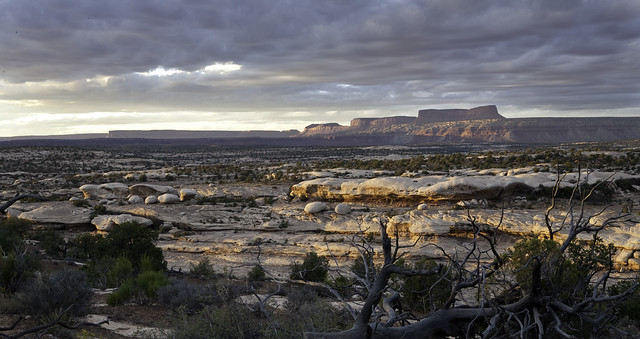

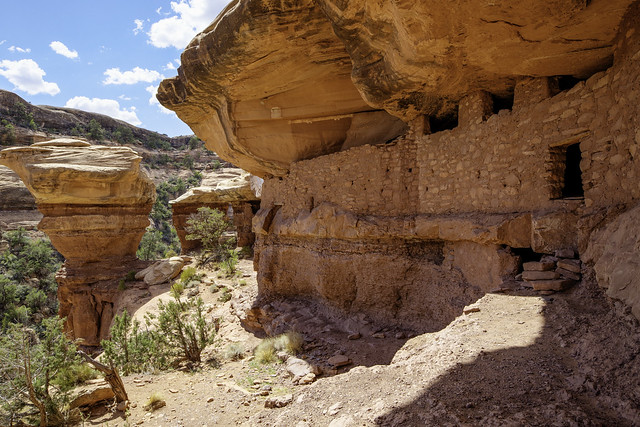


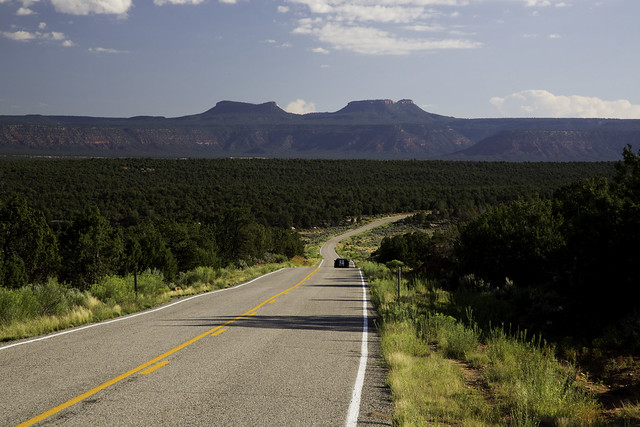
1 comment:
Rose pandas are the latest trend in stuffed animals and are sure to be a big hit this holiday season. These adorable creatures are perfect for cuddling and make great gifts for kids and adults alike. So if you're looking for a unique gift that is sure to bring a smile to someone's face, pick up a rose panda today!
Post a Comment